
 |
Tea Clipper |
 |
| from TeaAntiques.com | ||
| Edition Thirty Eight |
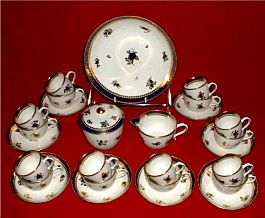 A
charming Caughley 'Blue & Gilt' part teaset comprising sucrier & cover, milk jug, bread & butter plate and eight trios (tea cup, coffee
cup and saucer). Each piece of this delightful set is marked on the underside
with the blue underglaze 's' Salopian mark of the Caughley factory.
A
charming Caughley 'Blue & Gilt' part teaset comprising sucrier & cover, milk jug, bread & butter plate and eight trios (tea cup, coffee
cup and saucer). Each piece of this delightful set is marked on the underside
with the blue underglaze 's' Salopian mark of the Caughley factory.
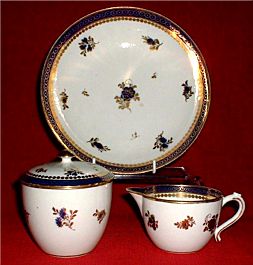 It
is rare to have an opportunity to purchase so much of one set from this
period.
It
is rare to have an opportunity to purchase so much of one set from this
period.
More details of this item and other tea related antiques can be found by visiting my web site at www.TeaAntiques.com.
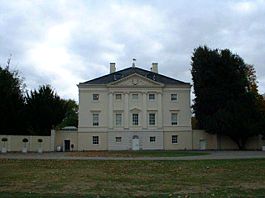 After
Christmas, to lift the spirits in the month of January, when the days in England
are short and cold, I thought I would share a delightful house with you. In the
autumn of last year, I visited a beautiful Palladian villa on the banks of the
river Thames at Twickenham, just West of London. This charming, rather modest in
appearance, classical white villa was the creation and home of Henrietta Howard,
a lady with a fascinating story.
After
Christmas, to lift the spirits in the month of January, when the days in England
are short and cold, I thought I would share a delightful house with you. In the
autumn of last year, I visited a beautiful Palladian villa on the banks of the
river Thames at Twickenham, just West of London. This charming, rather modest in
appearance, classical white villa was the creation and home of Henrietta Howard,
a lady with a fascinating story.
Henrietta had married, at the age of eighteen, Charles Howard, a younger son of the Earl of Suffolk. He was thirteen years older than her and a military man, a Captain in the Dragoons. Their time together was not easy as Charles was a gambler and got into serious debts. He was also a violent man and would often be drunk. After having been married for only three months, he sold his commission in the army.
They had one son, Henry and moved through several addresses and lodgings to escape their creditors. By now their marriage was in difficulty and they were all but separated.
Henrietta did have aristocratic connection and decided to travel to Hanover and became friends with the Electress of Hanover, mother of the future King George I. This eventually led her to securing a place in the English Royal Court, as the Lady of the Bed Chamber to George I’s daughter, Caroline, Princess of Wales. Henrietta’s husband Charles, was made Groom of the Bed Chamber to George I.
Despite Henrietta and Charles having secured places in the Royal Court, they were far from happy together. At this time the relationship between King George I and his son, the Prince of Wales had taken a turn for the worse too and the court was split. The Prince of Wales was ordered to move out of St James Palace and with him went Henrietta, whilst her husband, Henry stayed with the King.
The Prince and Princess of Wales moved to Leicester House and took Richmond Lodge as their summer retreat. Henrietta, had now become mistress to the Prince of Wales, a position accepted by the Princess of Wales. Indeed the Princess of Wales presented Henrietta with £11,500 of stock in trust, some jewellery and all her furniture and the furniture from her servants' rooms at Leicester House.
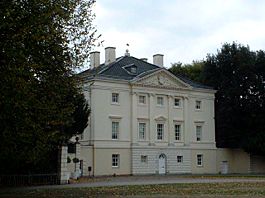
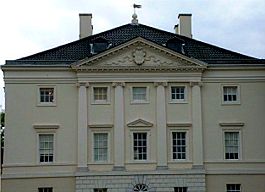
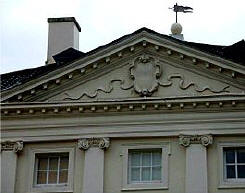
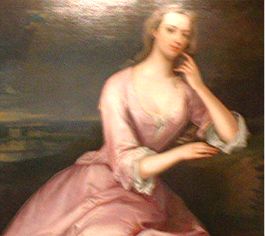 Henrietta
Howard, whose portrait is shown here, had ambitious plans to build
a house of her own at Twickenham, this she planned in secrecy, not
wishing her husband to know. The design of this delightful villa was the work of
the 9th Earl of Pembroke, a patron of the English Palladian revival.
Henrietta
Howard, whose portrait is shown here, had ambitious plans to build
a house of her own at Twickenham, this she planned in secrecy, not
wishing her husband to know. The design of this delightful villa was the work of
the 9th Earl of Pembroke, a patron of the English Palladian revival.
Work on the house was started in 1724 on the site of Marble Hill where poet Alexander Pope was her neighbour. The house went up apace, but came to a halt still missing its staircase, ceilings and fittings. George I had died and so the Prince of Wales became King George II. Henrietta thought that as King, he would now loose interest in her, but this was not to be and increased her allowance from £2,000 to £3,200. A legal separation was drawn up with her husband and her new house was completed by 1729.
Strangely, on the death of the 8th Earl of Suffolk, he left his possessions not to his younger brother Charles, but to his favourite sister-in-law, Henrietta Howard. Although legally separated from Charles, she found herself Countess of Suffolk. Queen Caroline gave her a new position as Mistress of the Robes. Eventually, in 1734 aged 46, she left the Court. Her husband Charles had died and a year later she had married George Berkley. They lived at Marble Hill with the children of Henrietta’s brother John, whose wife had died in 1727. Henrietta was married to George Berkley for eleven years, before he too died.
By now, Horace Walpole, a near neighbour was a frequent visitor and friend to Henrietta at Marble hill. She died in 1767 at the grand old age of seventy-nine. Despite being deaf, she was a woman of wit and great conversation.
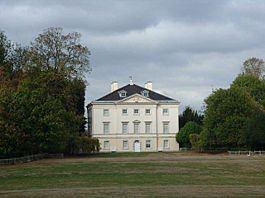
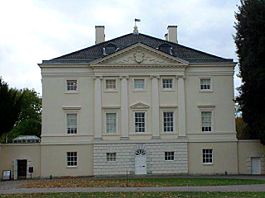
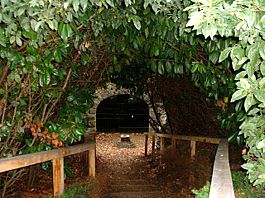 The
house as we see it today, is much as it would have been seen by Henrietta
Howard. Rather stark Palladian in style, it stands proudly on the banks of the
river Thames. The formal gardens no longer exist and it is surrounded by grass
parklands with some specimen trees around it. There are the remains of the
'grotto' in the grounds, similar to one in the grounds of Alexander Pope's
The
house as we see it today, is much as it would have been seen by Henrietta
Howard. Rather stark Palladian in style, it stands proudly on the banks of the
river Thames. The formal gardens no longer exist and it is surrounded by grass
parklands with some specimen trees around it. There are the remains of the
'grotto' in the grounds, similar to one in the grounds of Alexander Pope's
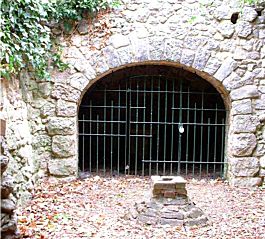 house
near-by, this one at Marble Hill, but a shadow of its former romantic self.
Viewed from the other side of the river, the house shows the typical Palladian
design having a lower rustic base upon which stands the grander rooms of the
piano noble. A square block, the main part of the house no longer has the
kitchen block attached, these have long since been demolished.
house
near-by, this one at Marble Hill, but a shadow of its former romantic self.
Viewed from the other side of the river, the house shows the typical Palladian
design having a lower rustic base upon which stands the grander rooms of the
piano noble. A square block, the main part of the house no longer has the
kitchen block attached, these have long since been demolished.
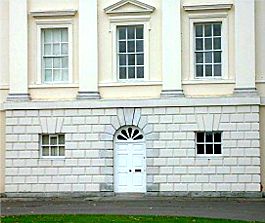 From
the non-river front, the elevation appears much the same. A central door in the
rusticated base leads to the stairs to take guests up to the grand ‘Great Room’
on the first floor. The staircase constructed from the finest Spanish mahogany
that was given to Henrietta by the King, this wood nearly caused a diplomatic
incident when the trees were felled in Spain by the British Navy!
From
the non-river front, the elevation appears much the same. A central door in the
rusticated base leads to the stairs to take guests up to the grand ‘Great Room’
on the first floor. The staircase constructed from the finest Spanish mahogany
that was given to Henrietta by the King, this wood nearly caused a diplomatic
incident when the trees were felled in Spain by the British Navy!
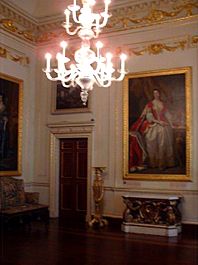
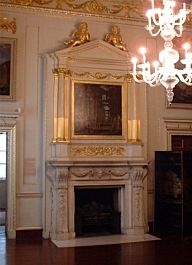 This,
the ‘Great Room’, is the epitome of the Palladian style of the period, used for
formal entertaining it has exquisite and quite unexpected grandeur for a house so
modest in size. There is a mass of classical decoration in the plaster work on the
walls, ceiling and fireplace. This richly gilded plasterwork contrasts
beautifully with the plain white walls. Much of the original furniture to the
house has been dispersed, but there are a few pieces that remain. One such piece
is one of four marble topped tables, the under frame carved with a supportive
peacock.
This,
the ‘Great Room’, is the epitome of the Palladian style of the period, used for
formal entertaining it has exquisite and quite unexpected grandeur for a house so
modest in size. There is a mass of classical decoration in the plaster work on the
walls, ceiling and fireplace. This richly gilded plasterwork contrasts
beautifully with the plain white walls. Much of the original furniture to the
house has been dispersed, but there are a few pieces that remain. One such piece
is one of four marble topped tables, the under frame carved with a supportive
peacock.
There are five panels around the room that contain paintings by Giovanni Paolo Panini and date from 1738. These glorious classical paintings show typical Roman scenes of temples and ruins. The room is lit by a handsome English cut glass Chandelier, rather plain in appearance, but elegant and extremely suited to this room.
The room is based on a single cube giving it superb proportions. The windows are furnished with deep red damask curtains - as was the fashion of the day.
There are three full length portraits on the walls of this room, which are copies of the originals that originally hung here - now lost. This is a case of history repeating itself, because the originals too were copies of of paintings after Van Dyke and Rubens.
Guests to the house would be allowed to tour the rooms on this floor, these would include the dressing room to the right, hung with green damask wall hangings. And to the left, Lady Suffolk’s bed chamber again hung round with rich green wall coverings. Behind the dressing room is the red Damask bedroom and behind Lady Suffolk’s bedchamber, a further bedchamber.
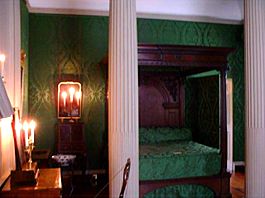
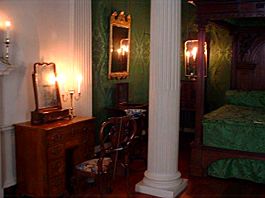
In Lady Suffolk’s bed chamber there is a colonnade of Ionic columns which give the impression of dividing the room, the bed at the far end beyond the columns. On the front side of the columns is the fireplace and furniture such as the kneehole desk on which stands a walnut toilet mirror, this having a wonderful scalloped topped swing mirror above a shapely set of drawers. Henrietta died in this room and in her old age would have entertained guests such as Sir Horace Walpole here where they would talk about her fascinating stories and her life at the Royal Court.
The four poster bed, 1740 in date and has a mahogany frame, would be similar to Henrietta’s own bed.
The dressing room on the other side of the ‘Great Room’ is where Henrietta would attend to her final dressing and make-up and where she would receive guests and also deal with daily correspondence. Hanging on one wall is a fine portrait of Henrietta Howard in a relaxed pose, wearing a sumptuous pink silk dress, her hair flowing loosely in rather a seductive manor.
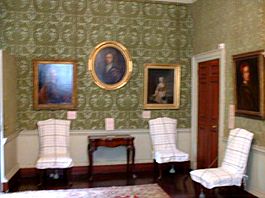
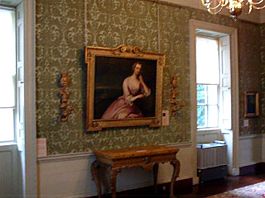
Above the piano noble floor, are a further two floors. The top floor, providing garret room accommodation for servants and the floor below, a long gallery and further bedrooms. Access to these floors is via a simple narrow stone staircase behind a door on the main landing. The long gallery would have afforded stunning views across the Thames and may have been used for exercise in inclement weather.
Returning to the ground floor of the house, there are some rooms of small proportion, with relatively low ceilings. Beyond the grand staircase entrance is an inner stone hall. This stone hall also allowed access to the house from the Thames side, should guests arrive by boat. To one side of this hall is the dining parlour, a room now rather plain in appearance, but originally hung with hand painted Chinese wall paper.
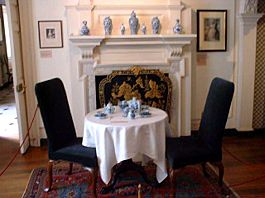 To
the other side of the stone hall is the breakfast parlour. A charming little
room, the walls hung with portraits and prints of Henrietta’s friends,
including Alexander Pope and Horace Walpole. In Henrietta’s day, this room would
have been used for informal breakfasts with friends. The pillared screen at the
far end of the room probably housed a beautiful side board, used to hold the
food and silverware at breakfast.
To
the other side of the stone hall is the breakfast parlour. A charming little
room, the walls hung with portraits and prints of Henrietta’s friends,
including Alexander Pope and Horace Walpole. In Henrietta’s day, this room would
have been used for informal breakfasts with friends. The pillared screen at the
far end of the room probably housed a beautiful side board, used to hold the
food and silverware at breakfast. 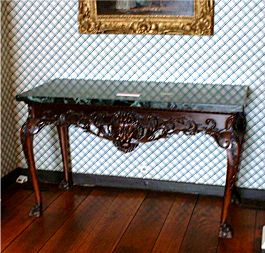 Today standing in place of the side board a
remarkable marble topped side table. this delightful table has a delicate carved
mahogany apron and cabriole shaped legs terminating in fine ball and claw feet.
Today standing in place of the side board a
remarkable marble topped side table. this delightful table has a delicate carved
mahogany apron and cabriole shaped legs terminating in fine ball and claw feet.
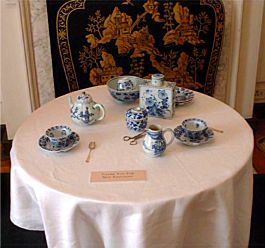 In
the breakfast room on my visit, there was a delight for the lover of tea
antiques - a small circular tripod table set for tea. How stunning the oriental
blue and white porcelain looked set upon a crisp white table cloth, a real joy
to see. There was a tiny blue and white teapot, tea bowls and saucers of various
designs, tea canisters, sparrow beaked milk jug, slops bowl and a charming pair
of silver sugar nips. The table had round it some very handsome early English
side chairs.
In
the breakfast room on my visit, there was a delight for the lover of tea
antiques - a small circular tripod table set for tea. How stunning the oriental
blue and white porcelain looked set upon a crisp white table cloth, a real joy
to see. There was a tiny blue and white teapot, tea bowls and saucers of various
designs, tea canisters, sparrow beaked milk jug, slops bowl and a charming pair
of silver sugar nips. The table had round it some very handsome early English
side chairs.
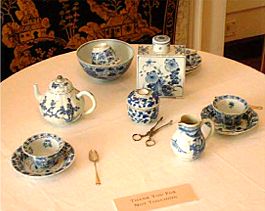 To see this little tea set up was a lovely way to end my visit to
what is a magical little Palladian villa from the eighteenth century.
To see this little tea set up was a lovely way to end my visit to
what is a magical little Palladian villa from the eighteenth century.
I hope that when the house re-opens for the season in Spring 2004, that you may have the good fortune to pay this little paradise a visit.
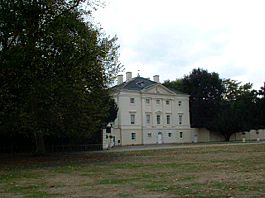 Marble
Hill House
Marble
Hill House
Twickenham
London
Website:
www.english-heritage.org.uk
Click here for
Local Map
Map courtesy of www.streetmap.co.uk
To review past newsletters, just follow this link:
Past newsletters.
To subscribe to this free newsletter -
Click here